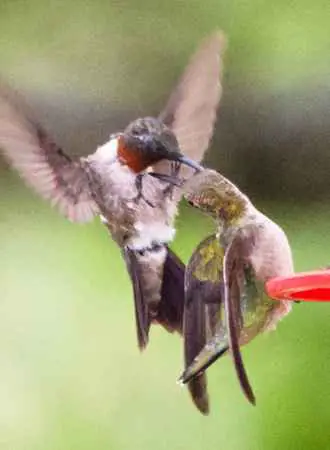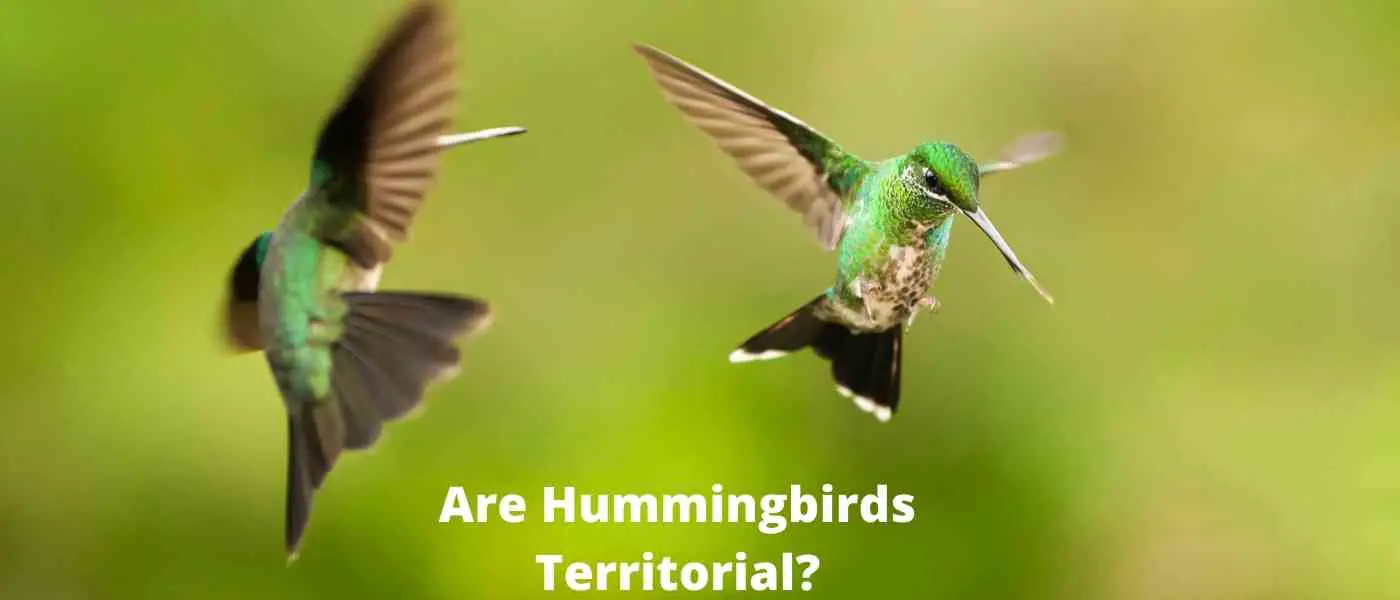Hummingbirds are fiercely territorial when it comes to their food sources. They will attack other hummingbirds that come too close to their feeding territory, as well as any other animals that might try to take away their nectar. This protectiveness is what makes it so difficult to get close to a hummingbird while it’s feeding.
Why Are Hummingbirds So Territorial?
Most hummingbirds start with the least aggressive behavior. But more hummingbirds can become more aggressive and territorial when it comes to their food sources. This is because there is a limited amount of nectar available, and the birds don’t want to have to fly long distances to find more.
Aggressive hummingbirds will often compete with each other for the best feeding spots, and they will show their aggressive behavior when defending their territory. This behavior is necessary for the survival of the hummingbird, and it helps to ensure that the bird has enough food to eat.
When it’s breeding season, a male hummingbird will establish a different type of territory. From a high perch, he watches his surroundings. Any other male will be chased away.
So how do hummingbirds show aggression? Hummingbirds can be surprisingly aggressive. They often chase and fight each other as a form of aggression or dominance.
An aggressive hummer may also produce a loud chirp sound or aggressive noises, dive, and change their posture. For instance, Rufous hummers flare their brightly-colored gorget.

Do Hummingbirds Compete for Nectar Sources?
One of the things hummingbirds compete for is flower nectar. Nectar is a sugary liquid that hummingbirds need for energy. They use their long beaks and tongues to lap up the nectar from flowers.
Some people have mistaken hummingbirds fighting for playing. But this is not the case. There’s fierce competition among hummingbirds for flower nectar. They often chase each other away from prime feeding spots. In some cases, they even fight each other. When these birds fight, they will use their sharp beaks and claws as weapons.
Why Do Hummingbirds Fight?
Hummingbirds are known for their aerial displays and their prowess in flying. However, they are also known to fight with other birds. There are various reasons why these birds engage in such behavior.
One reason why hummingbirds fight is to protect their food supply. These birds are very territorial and will defend their feeding grounds from other birds. They will also fight to defend their nesting sites.
Some hummingbirds also engage in fighting behavior as a way of establishing dominance. Male hummingbirds will often fight with each other in order to assert their dominance over a particular area. This type of fighting usually does not result in any serious injuries.

Why Do Hummingbirds Chase Each Other?
The answer to this question lies in the bird’s natural mating instincts. Male hummingbirds chase each other in order to gain the attention of the female they are interested in. They also do this to assert their dominance over other males in the area.
The courtship ritual of chasing and displaying is essential for these birds in finding a mate and ensuring the continuation of their species. While it may look like aggression to us, this behavior is actually quite normal for hummingbirds.
So the next time you see them chasing each other around, remember that they’re just following their instincts.
How Can I Reduce Hummingbird Aggression?
The best way to reduce the aggression of a bully hummingbird is to remove their perch or prune their favorite branch. By doing this, they won’t chase away other hummingbirds trying to feed. Additionally, you can try to provide more food sources so that the hummingbirds have less of a reason to be territorial. Another way of addressing bully hummingbirds is to the separation of feeder placement.

How Do You Stop Hummingbirds From Fighting Over Hummingbird Feeders?
Hummingbirds are among the most beautiful and popular backyard birds (see our guide to birds that look like hummingbirds), and many people enjoy attracting them to their yards with hummingbird feeders. However, these tiny birds show territorial behaviors and they often fight over access to feeders. Territorial aggression presents in a lot of ways such as aggressive sounds or they may raise feathers.
If you own a hummingbird feeder, you know there is always that one territorial hummer who will react aggressively when they see many birds flocking to its one feeder.
The best response to hummingbird harmony and temper their territorial aggression is to create more feeding stations by adding more hummingbird feeders. By providing multiple feeders and more feeding zones in different parts of the yard, some of which will be out of sight, you can give each bird its own territory and reduce the chances of a conflict. A dominant hummingbird cannot defend every feeder which gives less aggressive hummingbirds more chances to feed. Plus, hummingbirds will flock to a yard if they hear the fighting and feeding sounds.
According to Bob Sargent, a long-time hummingbird bander and one of Alabama’s foremost bird experts, people should increase the number of feeders around July 4th.
You can also try using different types of feeders, such as tube feeders or hummingbird baths, which tend to be less controversial than traditional hanging feeders.
Additional hummingbird advice is to group all feeders closely together. This setup is particularly effective in the late spring and summer. The dominant bird will get overwhelmed when more adult and young birds come in to get their fill.
Don’t forget to clean your feeders regularly to ward off diseases and prohibit nectar from spoiling.
By creating a hummingbird-friendly environment, you can stop territorial behavior and enjoy more birds without having to deal with the drama of fighting.
Are Hummingbirds Territorial Towards Humans?
Hummingbirds generally show the least aggressive behavior towards humans. They only attack humans if they feel threatened. This can happen during a territorial dispute, when a male is trying to court a female, or when a mother is protecting her young.
When a hummingbird feels threatened in their feeding or breeding territory, it can become very territorial and aggressive. They may make warning sounds to ward off unwanted visitors.
If you find yourself in the middle of a hummingbird territorial dispute, it’s best to step away and give them some space. If a hummingbird is attacking you, try to cover your face and head with your hands to protect yourself.
If a mother hummingbird is attacking you, it’s probably because she thinks you’re a threat to her babies. In this case, it’s best to back away slowly and give her some space.

Are Male Hummingbirds More Aggressive Than Females?
Male hummingbirds are more aggressive than females, especially when it comes to food. However, when it comes to their nests and young, females are much more aggressive.
This difference in behavior may be due to the different roles that males and females play in the hummingbird species. Males typically mate with multiple females and are not involved in the nesting or raising of young, while females are solely responsible for these tasks.
As a result, females must be more defensive of their nests and young in order to ensure their survival. The different roles and behaviors of male and female hummingbirds illustrate the importance of sexual dimorphism in this species.
What Hummingbird Species Is the Most Aggressive?
Rufous Hummingbirds are one of the smallest birds in North America, measuring only three to four inches in length. Despite their small size, they are considered the most aggressive of all hummingbirds.
Males have particularly territorial behavior, and will vigorously defend their feeding and nesting areas from multiple hummingbirds, even those much larger than themselves.
Rufous Hummingbirds will also sometimes chase away mammals such as squirrels and chipmunks that come too close to their nests.

The Bottom Line on the Territorial Behavior of Hummingbirds
Being aggressive is a common hummingbird behavior. An aggressive hummingbird will fight other hummers for control over prime feeding areas, and they can be quite territorial when it comes to their nests.
While all hummingbirds are known for their quick movements and aerial acrobatics, some species, like the rufous hummingbird, can be particularly feisty. If you’re lucky enough to see rufous hummers in your backyard, take a moment to enjoy these fierce little hummingbird friends – but be careful not to anger them! Happy hummingbird watching!
FAQ on Hummingbirds
What Is the Difference Between a Female and Male Ruby-Throated Hummingbird?
A male ruby-throated hummingbird has a recognizable ruby-red throat while the female has a white throat. On rare occasions, a red feather may be seen in the white throat. Females have rounded tail feathers, while males have pointed tail feathers. Females have white tips on their outer three tail feathers.


